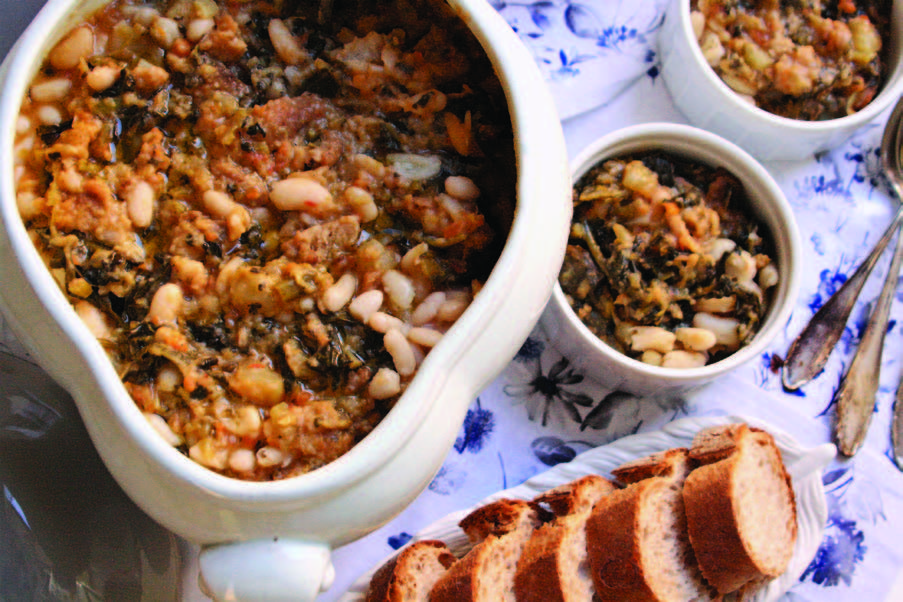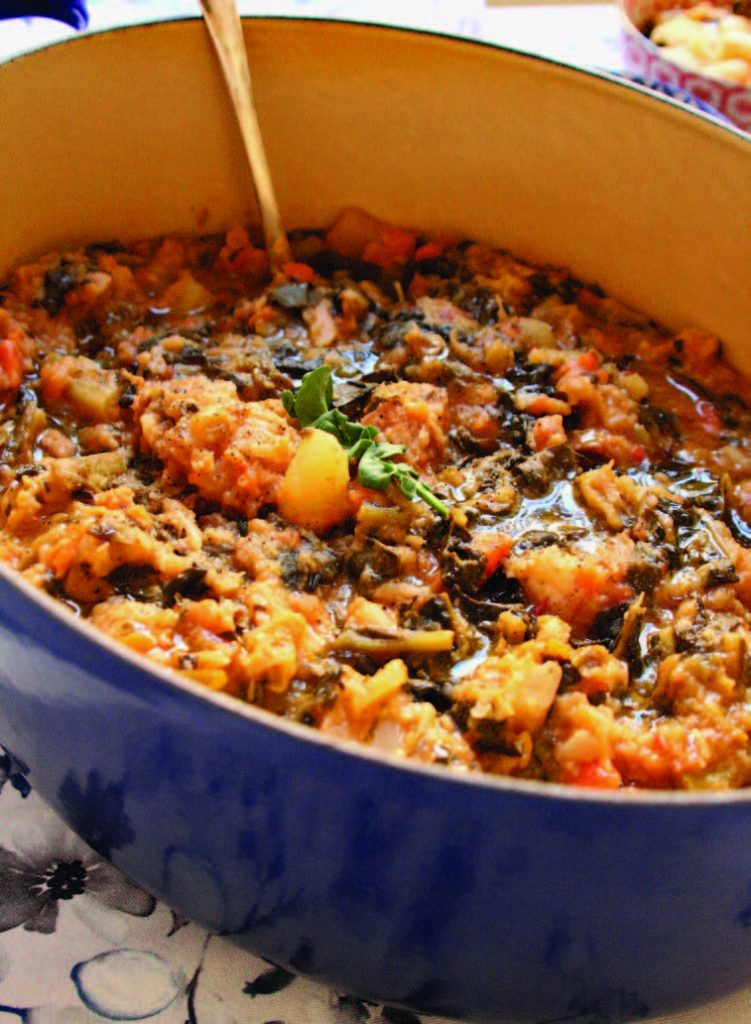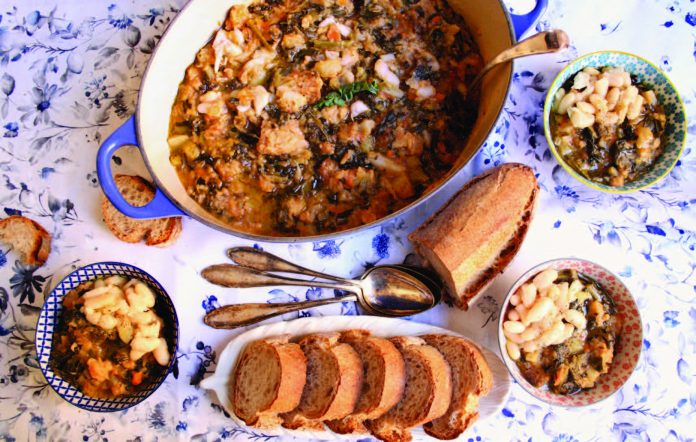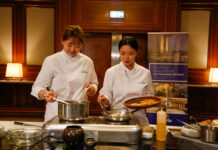
Although Rome certainly isn’t seeing arctic temperatures this winter, the fact that it is winter means that a comforting bowl of soup is always welcome, and I could happily eat soup every day. This is a good thing, because I never seem to be able to make small quantities of soup, instead making enough for a football team of hungry teenage boys! A recent weekend in Tuscany reminded me of a soup that can be found on many restaurant menus in Tuscany yet rarely makes an appearance in Rome. The word “ribollita” translates literally into “reboiled” and it is called that because the soup is made on one day, and then reheated (re-boiled) the following day. Ribollita is one of those ‘cucina povera’ (poor kitchen) recipes that is hearty, satisfying, delicious, and at the same time, inexpensive to make. Food waste is avoided by utilising stale bread and any vegetables that may be left over and sitting around in the kitchen, or quite basically, whatever could be found in the vegetable garden, but usually beans, kale, tomatoes and bread.
Make sure you use dried cannellini beans and soak them overnight – you will be rewarded for your patience. Another thing to note is that ribollita is not served with parmesan cheese on top – just a drizzle of your best Extra Virgin Olive Oil and a little freshly cracked black pepper.
Tuscany is a Region that is rich in history and famous for its breathtaking scenery. It extends from the Tyrrhenian Sea to the Apuan Alps, with more than 3.6 million inhabitants distributed over 10 provinces and Florence as the capital. Tuscan cuisine has ancient origins, dating back to the Etruscan people, and many of these influences can still be seen in present day. In the Renaissance, chefs working in the noble courts were expected to prepare very elaborate dishes, and these have subsequently left their influence on many other European countries’ cuisines, especially France.
Tuscan people, however, still love to cook much simpler dishes. Ancient Tuscany was inhabited by primeval colonies at first, and then by the Etruscans. The Romans followed, who were great lovers of wine and good food, and although their food was simple, in some ways it was quite varied for the time. Legumes (chickpeas, lentils, beans), spelt, barley and millet (used in soups), fruits, vegetables, wine and olive oil were indeed already being cultivated, and sheep, goats, pigs and cattle were being raised both for their milk and meat, and game (especially wild boar and deer) was often eaten by the Etruscans.

During the colonization of the Roman Empire, the Tuscan cuisine, of Etruscan origin, saw no major changes, remaining substantially frugal. With the decline of the Empire, the arrival in Italy of the barbarian tribes and the consequent depopulation of the cities in favor of the countryside with the advent of Feudalism, good cuisine was reserved for the richest and noble families, while the peasants and the workers had to survive, on vegetable soups and “poor food”. Interestingly, it is this “poor food” or “cucina povera” that is celebrated today in Italy.
Cucina povera comes from peasant traditions that arose out of necessity during hard times, although has been shown to meet the highest nutritional standards set by scientists, scholars and dietitians, hailing the benefits of the “Mediterranean diet”. But long before research and today’s healthy eating trends, Italian farm families living at a subsistence level who couldn’t afford to put any meat on their tables found a formidable alternative in beans, which are up to 25 percent protein in their dried form, and loaded with calcium, iron and fiber. Easy to cook and delicious, the bean is a meal in itself.
Traditional Tuscan food, and Italian food in general, encompasses three very important principles – simplicity, seasonality and quality.
Even today, Italians prefer to stay close to their roots, shopping daily at local food stores that take the time to find the best quality meat and produce, and often going to a different store for each. Today, more than ever Italians take pride in knowing where their food comes from, and believe in eating seasonally, celebrating produce at its seasonal peak.
RIBOLLITA
INGREDIENTS
- 400g dried cannellini beans
- 1 garlic clove
- Sprig of fresh rosemary
- 80mls extra virgin olive oil
- 1 onion
- 2 carrots
- 100g celery stalk & leaves
- 5 thyme sprigs (leaves only)
- 1 teaspoon salt
- 1 large potato
- 300g kale (Cavolo Nero in Italian)
- 250g Savoy cabbage (Verza in Italian)
- 200g Swiss chard (Bietola in Italian)
- 250mls canned tomato pulp or 1 large fresh tomato
- 200g whole wheat, rustic Tuscan-style stale bread
- To taste, freshly ground black pepper

PREPERATION
- Begin the night before by soaking the cannellini beans in 1.5 litres water with half a tablespoon of salt.
- Add the cannellini beans with their water to a saucepan, and add 1 whole garlic and the rosemary with a generous splash of olive oil. Boil lightly for 1 hour, or until beans are cooked and soft. Add extra water if required. Remove half a cup of the cannellini beans and set aside. Puree the remaining beans in their cooking water using a food processor or a hand-held blender i.e. Bamix.
- Chop onion, carrots and celery and add to a large saucepan with extra-virgin olive oil. This is your “soffritto”. Cook on medium-high heat until the onion is translucent and slightly golden, stirring to avoid burning.
- Wash the kale, cabbage and Swiss chard and chop roughly into pieces about 4cm long; peel and dice the potato.
- To the soffritto, add the thyme leaves, all the vegetables, the tomato pulp, the bean purée and 1 liter of water.
- Cook over a low heat, covered for about 1 hour.
- Stir through the beans that were set aside. Cut the bread roughly into large cubes, leaving the crust on. Stir through and cook for another 5–10 minutes.
- Leave ribollita for 4 hours, or preferably overnight. The bread will have time to absorb and soak up much of the liquid.
9. To serve, reheat, and serve with extra slices of rustic Tuscan bread and a little freshly cracked black pepper, and don’t forget the drizzle of good quality extra virgin olive oil!

















